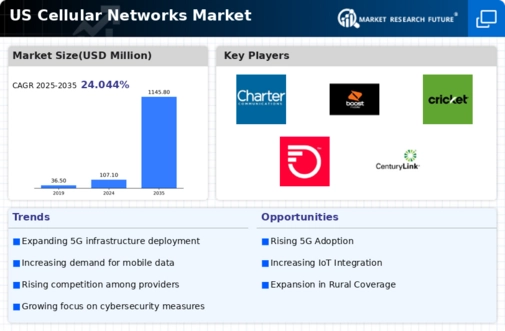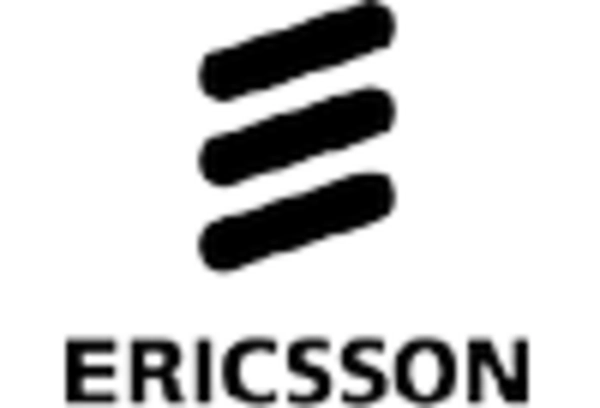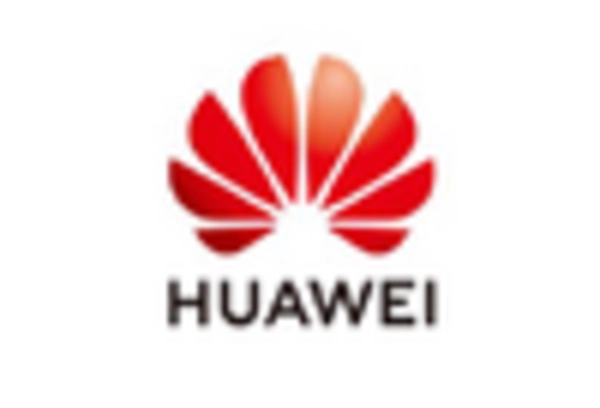Expansion of IoT Applications
The cellular networks market is significantly influenced by the rapid expansion of Internet of Things (IoT) applications. As industries increasingly adopt IoT solutions for automation, monitoring, and data collection, the demand for reliable cellular connectivity intensifies. In 2025, it is estimated that there will be over 30 billion connected IoT devices in the US, many of which rely on cellular networks for communication. This growth presents a substantial opportunity for network operators to diversify their service offerings and cater to various sectors, including healthcare, agriculture, and smart cities. The integration of IoT with cellular networks not only enhances operational efficiency but also drives innovation, thereby shaping the future landscape of the cellular networks market.
Emergence of Advanced Technologies
The emergence of advanced technologies is reshaping the cellular networks market in profound ways. Innovations such as artificial intelligence (AI), machine learning, and edge computing are being integrated into network management and operations. These technologies enable more efficient resource allocation, predictive maintenance, and enhanced user experiences. In 2025, it is anticipated that AI-driven solutions will account for a significant portion of network management strategies, potentially improving operational efficiency by up to 25%. Moreover, the integration of edge computing allows for data processing closer to the source, reducing latency and improving service delivery. As these advanced technologies continue to evolve, they are likely to drive further transformation within the cellular networks market, fostering a more agile and responsive telecommunications ecosystem.
Government Initiatives and Funding
Government initiatives and funding play a pivotal role in shaping the cellular networks market. In recent years, federal and state governments have recognized the importance of robust telecommunications infrastructure for economic growth and public safety. In 2025, the US government has allocated over $10 billion to support the expansion of broadband access, particularly in underserved areas. This funding is likely to accelerate the deployment of advanced cellular technologies, including 5G, thereby enhancing connectivity across the nation. Additionally, regulatory frameworks are evolving to facilitate the rapid rollout of new technologies, which may further stimulate investment in the cellular networks market. Such initiatives not only aim to bridge the digital divide but also promote competition among service providers.
Increased Mobile Device Penetration
The cellular networks market is witnessing a notable increase in mobile device penetration, which is a key driver of market growth. As of 2025, it is estimated that over 90% of the US population owns a smartphone, leading to a higher demand for mobile data services. This widespread adoption of mobile devices is accompanied by a growing expectation for seamless connectivity and high-quality service. Consequently, network operators are compelled to invest in infrastructure upgrades and enhancements to accommodate the rising number of users and their data consumption patterns. The proliferation of mobile applications and services further fuels this trend, as consumers seek more engaging and interactive experiences. Thus, the increased mobile device penetration is likely to have a lasting impact on the cellular networks market.
Rising Demand for High-Speed Connectivity
The cellular networks market is experiencing a surge in demand for high-speed connectivity, driven by the proliferation of data-intensive applications. As consumers increasingly rely on mobile devices for streaming, gaming, and remote work, the need for robust network infrastructure becomes paramount. In 2025, mobile data traffic in the US is projected to reach approximately 50 exabytes per month, indicating a growth rate of around 30% from previous years. This escalating demand compels service providers to enhance their network capabilities, thereby fostering competition and innovation within the cellular networks market. Furthermore, the advent of 5G technology is expected to play a crucial role in meeting these connectivity needs, as it offers significantly higher speeds and lower latency compared to its predecessors.
















